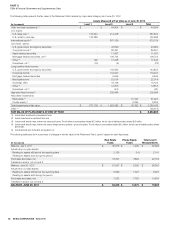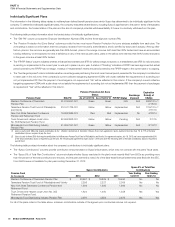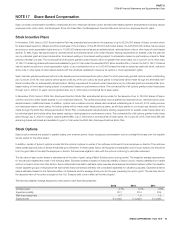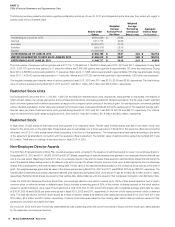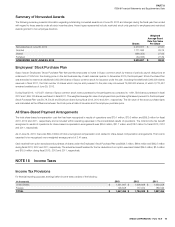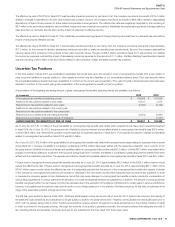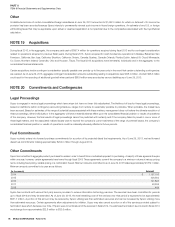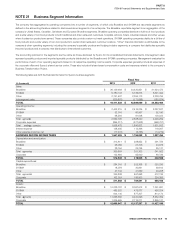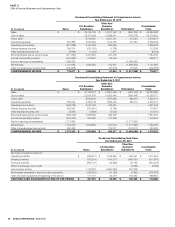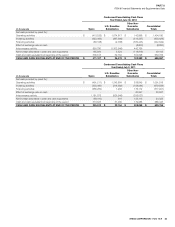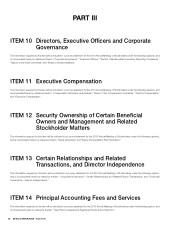Sysco 2013 Annual Report Download - page 88
Download and view the complete annual report
Please find page 88 of the 2013 Sysco annual report below. You can navigate through the pages in the report by either clicking on the pages listed below, or by using the keyword search tool below to find specific information within the annual report.
SYSCO CORPORATION-Form10-K 77
PARTII
ITEM8Financial Statements and Supplementary Data
The effective tax rate of 35.87% for scal 2013 was favorably impacted primarily by two items. First, the company recorded a tax bene t of $14.0million
related to changes in estimates for the prior year domestic tax provision. Second, the company recorded a tax bene t of $8.8million related to disqualifying
dispositions of Sysco stock pursuant to share-based compensation arrangements. The effective tax rate was negatively impacted by the recording of
$5.7million in tax and interest related to various federal, foreign and state uncertain tax positions. Inde nitely reinvested earnings taxed at foreign statutory
rates less than our domestic tax rate also had the impact of reducing the effective tax rate.
The effective tax rate for scal 2012 was 37.13%. Inde nitely reinvested earnings taxed at foreign statutory rates less than our domestic tax rate had the
impact of reducing the effective tax rate.
The effective tax rate of 36.96% for scal 2011 was favorably impacted primarily by two items. First, the company recorded a tax bene t of approximately
$17.0million for the reversal of valuation allowances previously recorded on state net operating loss carryforwards. Second, the company adjusted the
carrying values of the company’s COLI policies to their cash surrender values. The gain of $28.2million recorded in scal 2011 was primarily non-taxable
for income tax purposes, and had the impact of decreasing income tax expense for the period by $11.1million. Partially offsetting these favorable impacts
was the recording of $9.3million in tax and interest related to various federal, foreign and state uncertain tax positions.
Uncertain Tax Positions
In the third quarter of scal 2013, we reclassi ed a receivable that would arise upon the resolution of an unrecognized tax bene t from a net position in
other long-term liabilities to a gross position in other assets and other long-term liabilities on our consolidated balance sheet. Prior year amounts within
the consolidated balance sheets have been reclassi ed to conform to the current year presentation. Prior year amounts in schedule below have also been
adjusted to conform to the current year gross presentation of the unrecognized tax bene t on this tax position.
A reconciliation of the beginning and ending amount of gross unrecognized tax bene ts, excluding interest and penalties, is as follows:
(Inthousands)
2013 2012
Unrecognized tax bene ts at beginning of year $ 103,988 $ 107,925
Additions for tax positions related to prior years 15,431 2,479
Reductions for tax positions related to prior years (2,030) (2,154)
Additions for tax positions related to the current year - -
Reductions for tax positions related to the current year - -
Reductions due to settlements with taxing authorities (9,052) (2,831)
Reductions due to lapse of applicable statute of limitations - (1,431)
UNRECOGNIZED TAX BENEFITS AT END OF YEAR $ 108,337 $ 103,988
As of June29,2013, $11.6million of the gross liability for unrecognized tax bene ts was netted within prepaid income taxes due to expected payment
in scal 2014. As of June29,2013, the gross amount of liability for accrued interest and penalties related to unrecognized tax bene ts was $36.8million,
of which $5.8million was netted within prepaid income taxes due to expected payment in scal 2014. The expense recorded for interest and penalties
related to unrecognized tax bene ts in scal 2013 was $5.0million.
As of June30,2012, $15.9million of the gross liability for unrecognized tax bene ts was netted within prepaid income taxes relating to a payment that occurred
during scal 2011; however, the liability is considered outstanding until the matters have been settled with the respective jurisdiction. As of June30,2012,
the gross amount of liability for accrued interest and penalties related to unrecognized tax bene ts was $43.2million, of which $8.7million was netted within
prepaid income taxes relating to a payment that occurred during scal 2011; however, the liability is considered outstanding until the matters have been
settled with the respective jurisdiction. The expense recorded for interest and penalties related to unrecognized tax bene ts in scal 2012 was $4.7million.
If Sysco were to recognize all unrecognized tax bene ts recorded as of June29,2013, approximately $42.0millionof the $108.3million reserve would
reduce the effective tax rate. If Sysco were to recognize all unrecognized tax bene ts recorded as of June30,2012, approximately $37.1millionof the
$104.0million reserve would reduce the effective tax rate. It is reasonably possible that the amount of the unrecognized tax bene ts with respect to certain
of the company’s unrecognized tax positions will increase or decrease in the next twelve months either because Sysco’s positions are sustained on audit
or because the company agrees to their disallowance. Items that may cause changes to unrecognized tax bene ts primarily include the consideration of
various ling requirements in various states and the allocation of income and expense between tax jurisdictions. In addition, the amount of unrecognized tax
bene ts recognized within the next twelve months may decrease due to the expiration of the statute of limitations for certain years in various jurisdictions;
however, it is possible that a jurisdiction may open an audit on one of these years prior to the statute of limitations expiring. At this time, an estimate of the
range of the reasonably possible change cannot be made.
The IRS has open audits for Sysco’s 2006,2007,2008 and 2009 federal income tax returns. As of June29,2013, Sysco’s tax returns in the majority of
the state and local jurisdictions and Canada are no longer subject to audit for the years before 2007. However, some jurisdictions have audits open prior to
2007, with the earliest dating back to 2002. Certain tax jurisdictions require partial to full payment on audit assessments or the posting of letters of credit
in order to proceed to the appeals process. Although the outcome of tax audits is generally uncertain, the company believes that adequate amounts of
tax, including interest and penalties, have been accrued for any adjustments that may result from those open years.



